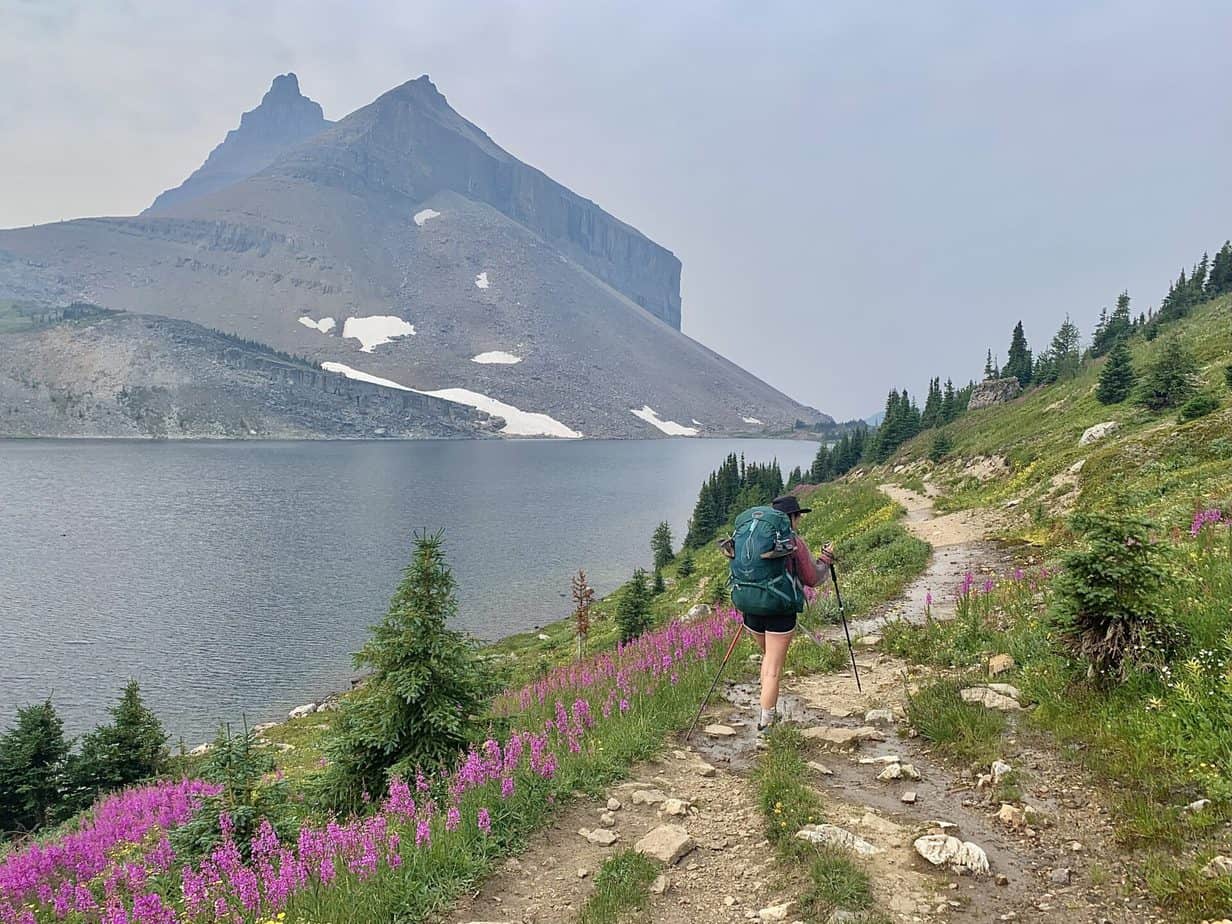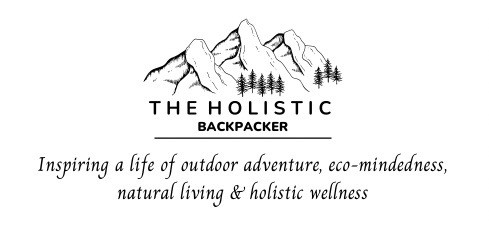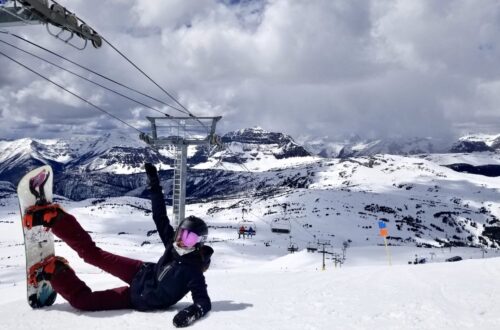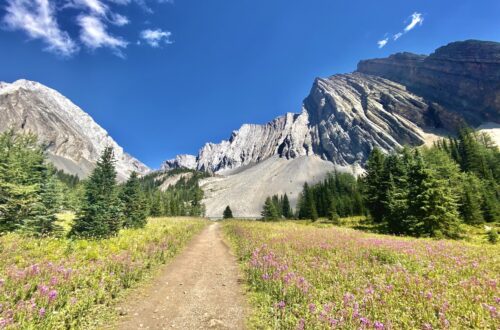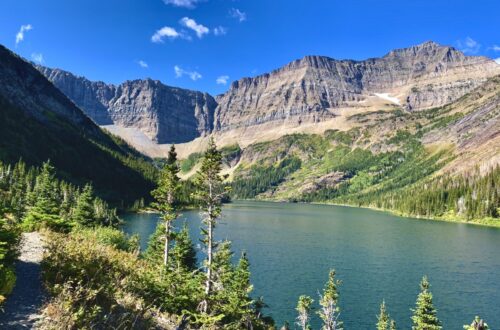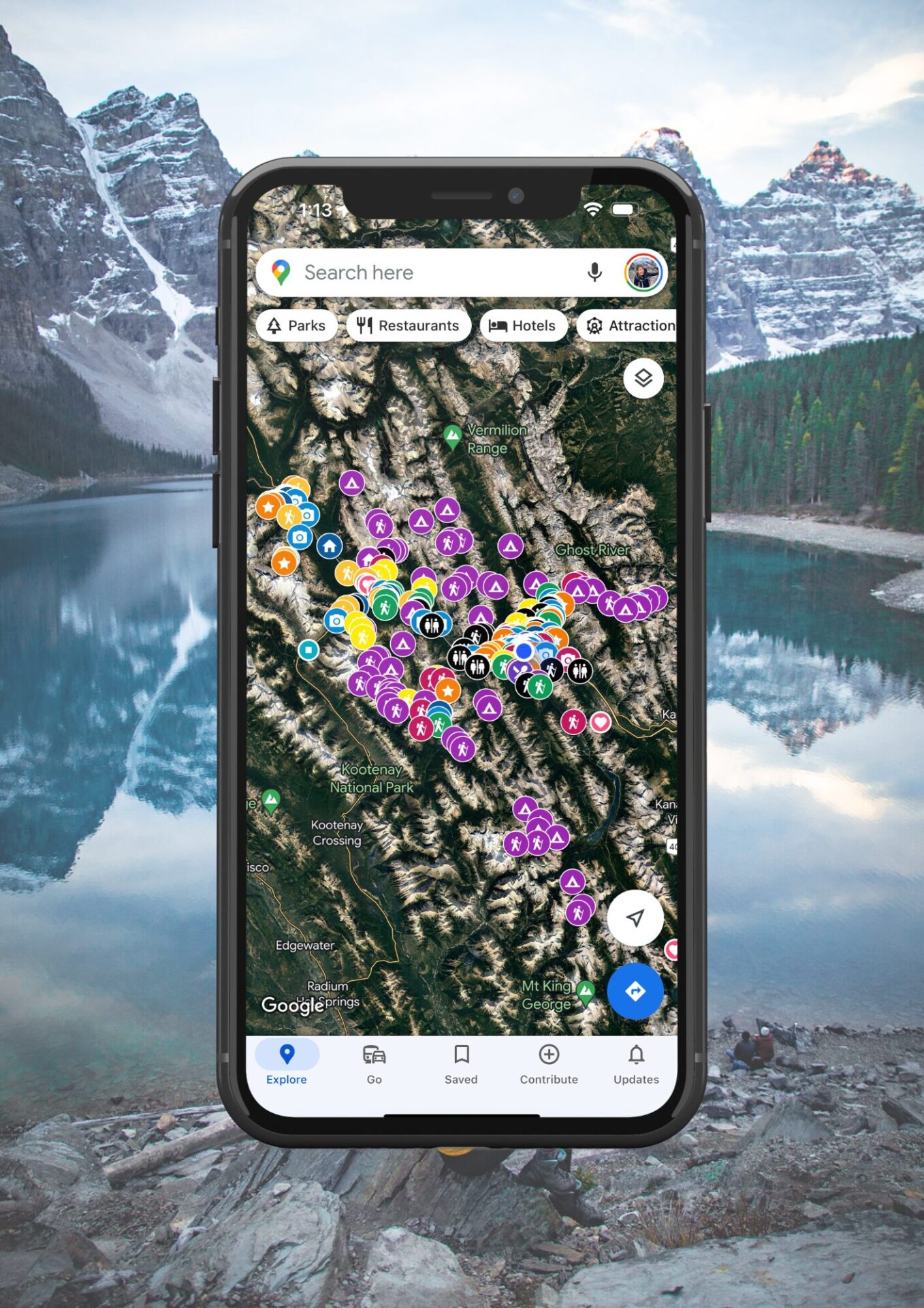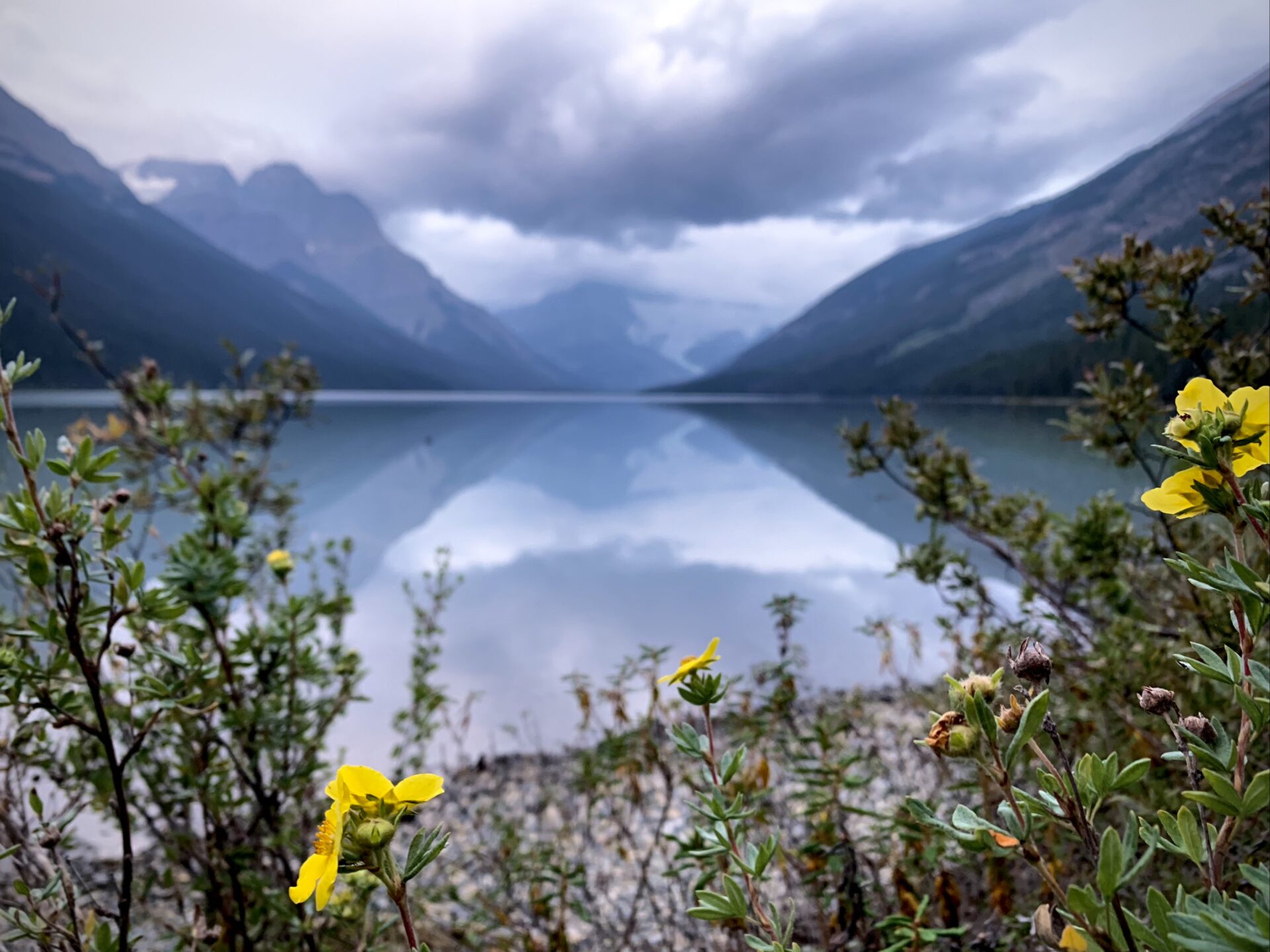
Glacier Lake Backpacking Trail – Banff National Park
‘Tranquility’ is the word I’d use to describe my Glacier Lake backpacking trip. 
Glacier Lake is the 4th largest lake in Banff National Park, measuring 4.5k long by 1km wide. Its size is impressive and its views are just the same. The lake is surrounded by mountains, glaciers, and a mature forest. The best part? It’s fairly easy to access!
You can day hike to the lake and back in about 4.5 to 6 hours, but I’d highly recommend spending at least one night camping to really appreciate the grand splendour that is the view you get from the campsites along shore.
Now, let’s go backcountry camping!
Skip Ahead:
- Getting to the Glacier Lake backpacking trail
- Where to stay along the Parkway
- Glacier Lake backpacking trail
- Glacier Lake backpacking campsite
- What to pack for Glacier Lake
- What to wear backpacking
- Tips for a successful trip
As you read this post, please consider clicking the links throughout. These are affiliate links which means when you book a hotel or purchase a product, I make a small commission at no additional cost to you (full disclosure). These commissions fund The Holistic Backpacker and help me write more blog posts.
Thank you for supporting my work!
Downloadable Banff Map
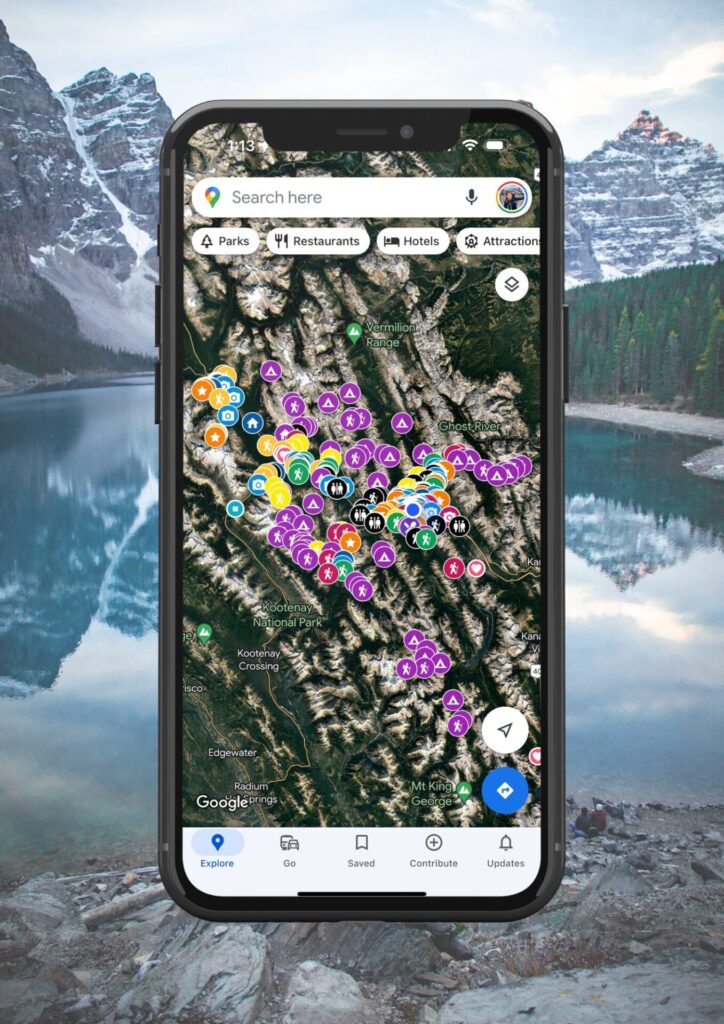
I’ve lived in Banff for years and I’ve now compiled everything I know about the park in this 600+ pin map which I made to help you explore Banff like a local.
The map outlines:
- 100+ hiking trails and backcountry campgrounds
- Every hotel, cabin, and restaurant in the park with ratings, reviews, and booking links
- Unique activities, photo-ops, and blue alpine lakes
- Transit hubs, planning resources, and parking maps
plus plenty of local hidden gems & insider travel tips!
Each pin comes equipped with photos, a description, booking links, and complete guides – designed with the intention of minimizing pre-travel research before your next trip to Banff.
Quick Banff Guide
Parks Pass: You will need a National Park Pass for each day you’re in Banff. Passes can be purchased at the East Parks Gates, the Visitor Centre, any of the campgrounds, or online. If you’ll be in any of Canada’s National Parks for more than 7 days in a 365 day period, an annual Discovery Pass offers a better rate than purchasing individual day passes.
How to get to Banff: fly into Calgary International Airport. From here, rent a car, RV, or take one of the following shuttles to Banff:
- Budget: On-It runs during the summer months and Pop-a-Ride is a ride-share program. You can use my Poparide link to save $5 on your first trip.
- Top private shuttles: Banff Airporter and Brewster.
- Car rental: having access to a car is the best way to travel to/from/within Banff. Here are the best budget car rental options for Canada.
Roam Transit: once you arrive in Banff, use the local transit service as much as possible. There are bus lines within town, plus lines to popular spots like Lake Louise and Johnston Canyon. The bus to Lake Louise should be reserved in advance.
Parking: the best spot to park is the free lot next to the train station. More information about parking in town can be found here and parking fees can be paid here. Bylaw is strict, so ensure you’re following parking rules exactly.
Lodging & Camping: Here’s my guide for hotels in Banff (Organized by Category). If you’re visiting during peak summer (mid June to early September), make your lodging reservations FAR in advance. Front country and backcountry camping reservations must be made on the Parks Canada reservation system. The system typically opens in February and it’s recommended you make reservations then.
Reservations: for activities and restaurants should be made well in advance during summer. Get Your Guide and Viator are popular tour booking platforms whereas OpenTable is used for restaurants.
When to visit: Hiking – July to mid September. Backcountry camping, wildflowers, & water activities – July to August. Fall colours – mid September to early October. Wild ice skating – usually early December. Skiing (best snow), coldest temps & frozen waterfalls – January & February. Northern lights – December to February. Best spring skiing – March to April. Quietest months to visit – April, May, October, and November.
Visiting Moraine Lake or Lake Louise? Read my guide for how to get there with the new road closures. If you want to see Moraine Lake at sunrise, you can book a shuttle here.
Wildlife Safety: 11 ways to stay safe from wildlife, bear safety, & bear basics.
General Canada Travel Tips
Travel Insurance: ALWAYS purchase reliable travel insurance before your trip. This insurance is trusted by backpackers and adventure sport enthusiasts around the world. You can also use my link to receive 5% off SafetyWing policies. Here’s a blog post with more trustworthy travel insurance options you can compare.
Public transit is not common in North America, however every big city has their own local transit system. If you want to venture out of big cities or to any natural spot, plan to rent a car – here are the best budget car rental options in Canada. Trains (Via Rail) are not well connected within the country and are expensive. Hitchhiking is relatively uncommon here, however Poparide is becoming more popular for ride sharing.
Phone: popular providers are Rogers, Telus, and Koodoo. SIM cards can be purchased at the airport, phone stands, or provider storefronts. Canada has some of the most globally expensive phone rates.
Language: English & French (in Quebec).
Currency: Canadian dollars – displayed as “$” or “CAD”. Both cash and card are accepted everywhere.
Visas are typically not needed for stays up to 6 months in Canada.
Tipping culture: You are expected to tip 15-20% minimum on every meal. You are also expected to tip drivers, hair dressers, or anyone providing a “service” to you.
Tax: is not included in the price you see. Each province has their own tax bracket – Alberta 5%, Ontario 13%, British Columbia 12%, etc.
Helpful Banff Blog Posts
- 25+ Epic Lake Louise Hikes
- Step-by-step guide for planning a trip to Banff
- Best Hotels in Banff – Organized by Category
- How to get to Moraine Lake & Lake Louise
- 50+ Things to do in Banff in summer
- 30+ Epic things to do in Banff in winter
- Complete guide to the Icefields Parkway
- 12 Easy Hikes in Banff
Getting To The Glacier Lake Backpacking Trail
Glacier Lake is located along the Icefields Parkway, a highway that connects Banff and Jasper. The trailhead is located just past the Saskatchewan River Crossing if you’re coming from Banff or Red Deer. Conversely, it’ll be located just before the Crossing if you’re coming from Jasper. The trailhead is hard to miss, it has a sign indicating where to turn off from the main highway.
The hike to the lake is fairly quick, so consider doing one of the many beautiful stops along the parkway before hitting the trail. Mistaya Canyon is located 6.4km/8 minutes south of the trailhead; it’s a quick walk and leads to a gorgeous, fast flowing canyon that overlooks a glacier. A great addition to the trip if we’re sticking to the theme of glaciers.
More: here’s my complete guide to exploring the lakes, hiking trails and sights along the Icefields Parkway.
If you’re driving North (from Banff) along the parkway to get to the trailhead, you’ll pass Bow and Waterfowl Lakes. However my favourite place along the way – and the best kept Icefields Parkway secret – is this little dirt-road turn off right by the bridge that crosses the Saskatchewan River. There’s only room for a few cars, but it has the most amazing view of the river, 360 degrees of mountain views, and to top it, a few glaciers in the surrounding area. This spot is one of those “wow” places, and the best part is that no one really knows about it! Keep your eye out because it’s easy to miss, but this place is a great spot to have lunch before starting the hike in, or to have a snack on the way out.
*I’ve added some photos of these pitstops to the pins on the map.
Where to Stay Along the Parkway
The Icefields Parkway is a long stretch of highway that connects Banff National Park and Jasper National Park. Typically people drive the Parkway in one day and spend the night in Banff or Jasper. The general rule of thumb is you stay in Banff if you’re south of the Columbia Icefields and you stay in Jasper if you’re north of them. Here are the my top recommendations for lodging in Banff and Jasper:
- Banff – Fairmont Banff Springs (luxury), Banff Park Lodge (mid-range), Bow View Lodge (budget), Samesun Banff (hostel.)
- Jasper – Jasper Park Lodge and Pyramid Lake Lodge (luxury). Lobstick Lodge (mid-range), Jasper Gates Resort (budget), HI Jasper & Jasper Downtown Hostel.
If you want to extend your trip along the Parkway, there are a few hotels, hostels, and camping solutions scattered along the Parkway. The following are the best options:
- South of the Columbia Icefields: HI Mosquito Creek, HI Rampart Creek, and HI Athabasca Falls (hostels), The Crossing (at the Saskatchewan River Crossing).
- Columbia Icefields: Glacier View Lodge (luxury).
- North of the Columbia Icefields: Sunwapta Falls Rocky Mountain Lodge.
There are also plenty of reservable and first-come-first-serve campsites along the Parkway. Here’s information regarding the campgrounds on the Banff side of the highay and the Jasper side of the highway.
Glacier Lake Backpacking Trail
- Distance (roundtrip): 16.9km
- Elevation Gain: 870m
- Route Type: Out & Back
- Rating: Moderate
- Estimated Time (Roundtrip): 4.5 – 6.5 hours
This map comes from Alltrails. If you don’t have the app already, make sure you download it on your phone before hitting the trail.
Glacier Lake is rated as moderate and is considered a good trail as an introduction to backcountry camping. The trail is best used from May until September – I completed this hike on August 18/19, 2021 and had relatively warm sunny/cloudy weather both days.
The gals and I completed the trek to the lake in just over 2 hours and the trek back in about 2 hours, granted we were hiking at a relatively fast pace. This hike could easily be done as a day hike, but I do recommend camping for a night so you have more time to really appreciate the views.
The trail is very up & down the whole way and has LOTS of exposed roots. Watch your step! The trail starts out flat and then goes downhill until the bridge that crosses the North Saskatchewan River.
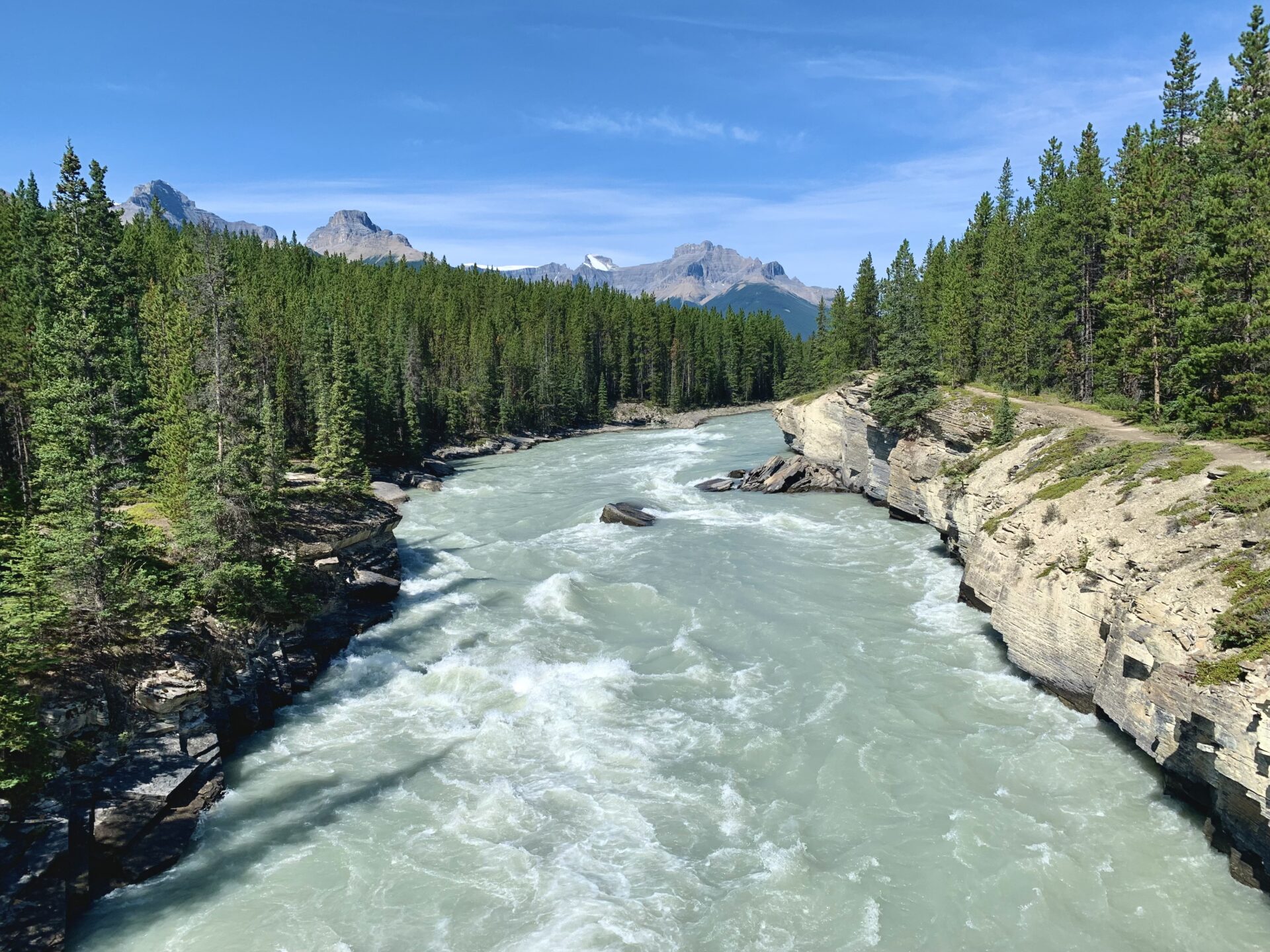
After this the trail has a quick, steep uphill grind and then is mostly flat until you come to the viewpoint for the Howse River Valley. Take a break here and relax on Banff’s classic red Adirondack chairs, the view is spectacular.
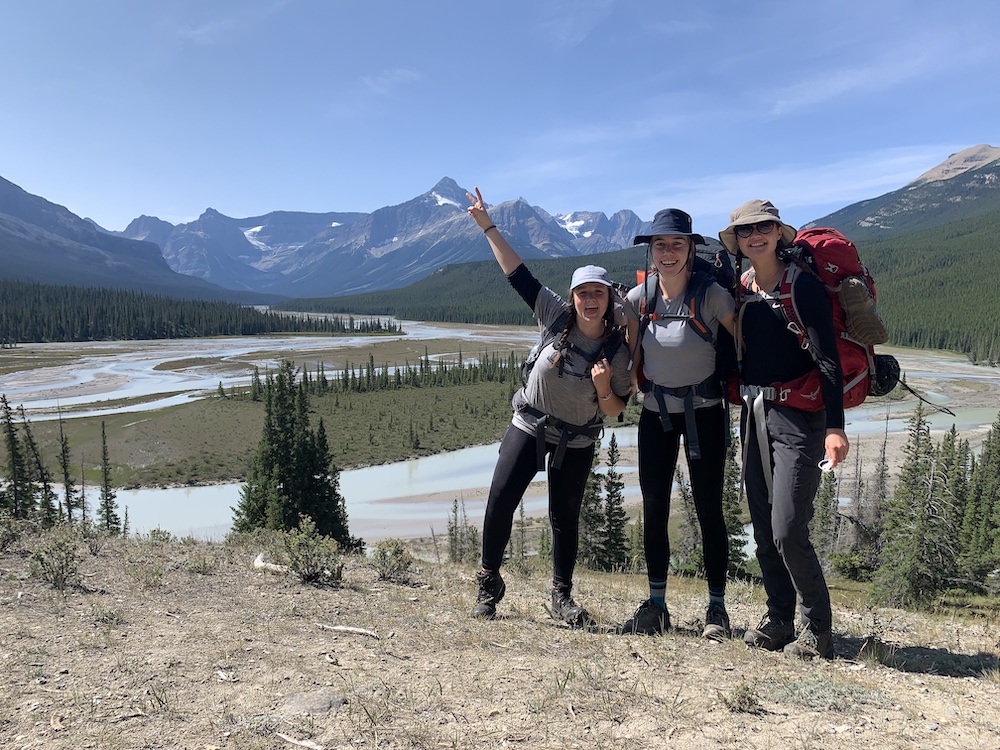
After this the trail turns right, goes downhill briefly, and then is mostly flat for about 1.5km. You will then reach a steady uphill section that stretches about 3km. After about 1.7km of downhill trekking you’ll reach the lake which boasts incredible views of Mount Outram, Division Mountain & Lyell Glacier, and Mount Erasmus. Enjoy the serenity that comes with this place!
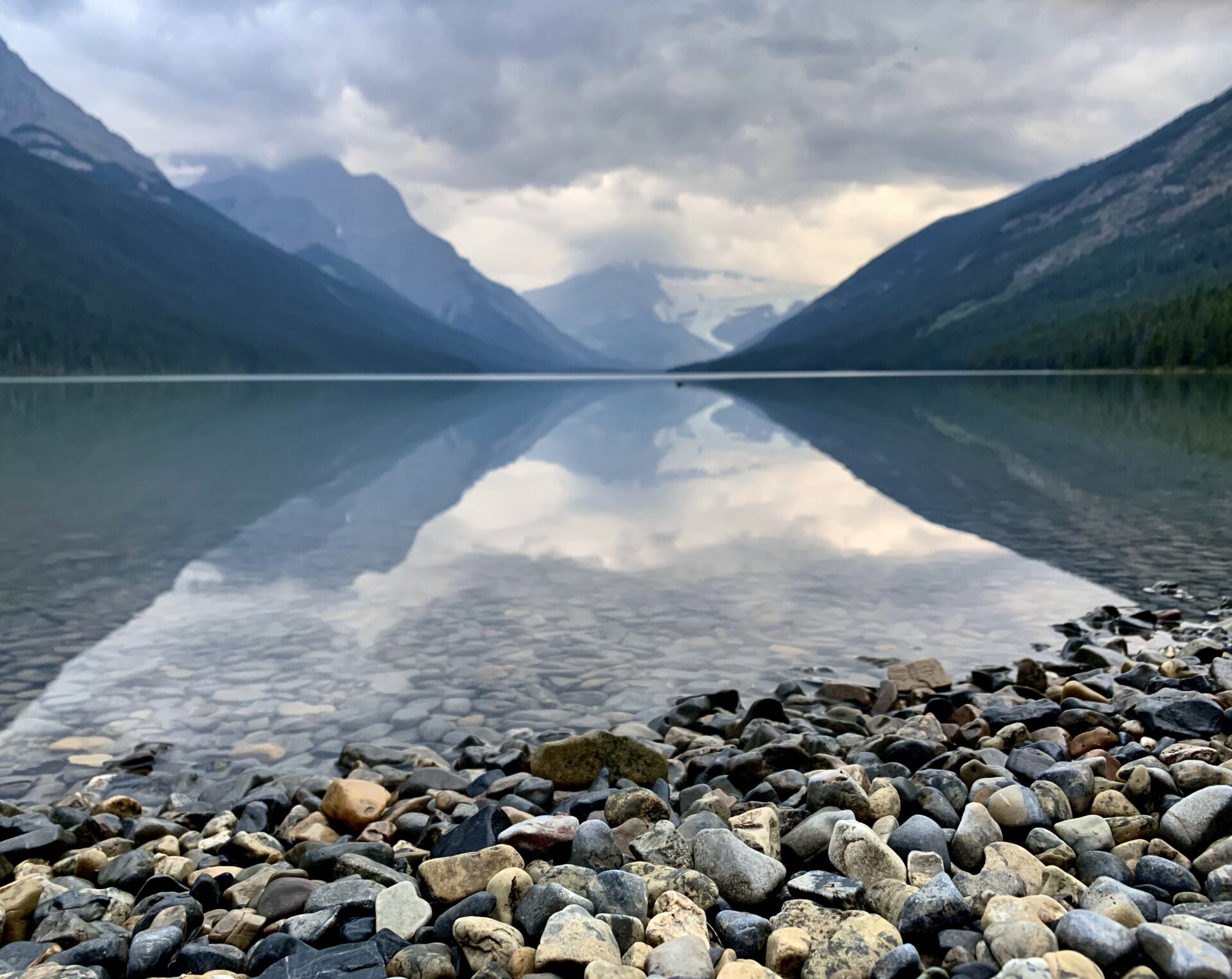
Glacier Lake Backpacking Campsites
To camp at Glacier Lake (GL 9) you must have a reservation. Reservations can be made through the Parks Canada reservations site, but be warned this campsite is a popular one. You normally have to book months in advance to get a spot or consistently check back for cancellations. It is well worth the effort!
In order to get here, you must hike. This means not only hiking yourself in, but also hiking in all your gear. Not sure what to pack for a Rocky Mountain backcountry camping trip? Check out my guide for all the essentials – I’ve learned the hard way what to pack and what not to pack!
Also keep in mind that whatever you pack in, you must pack out. Do your part to keep Canadian parks clean & beautiful!
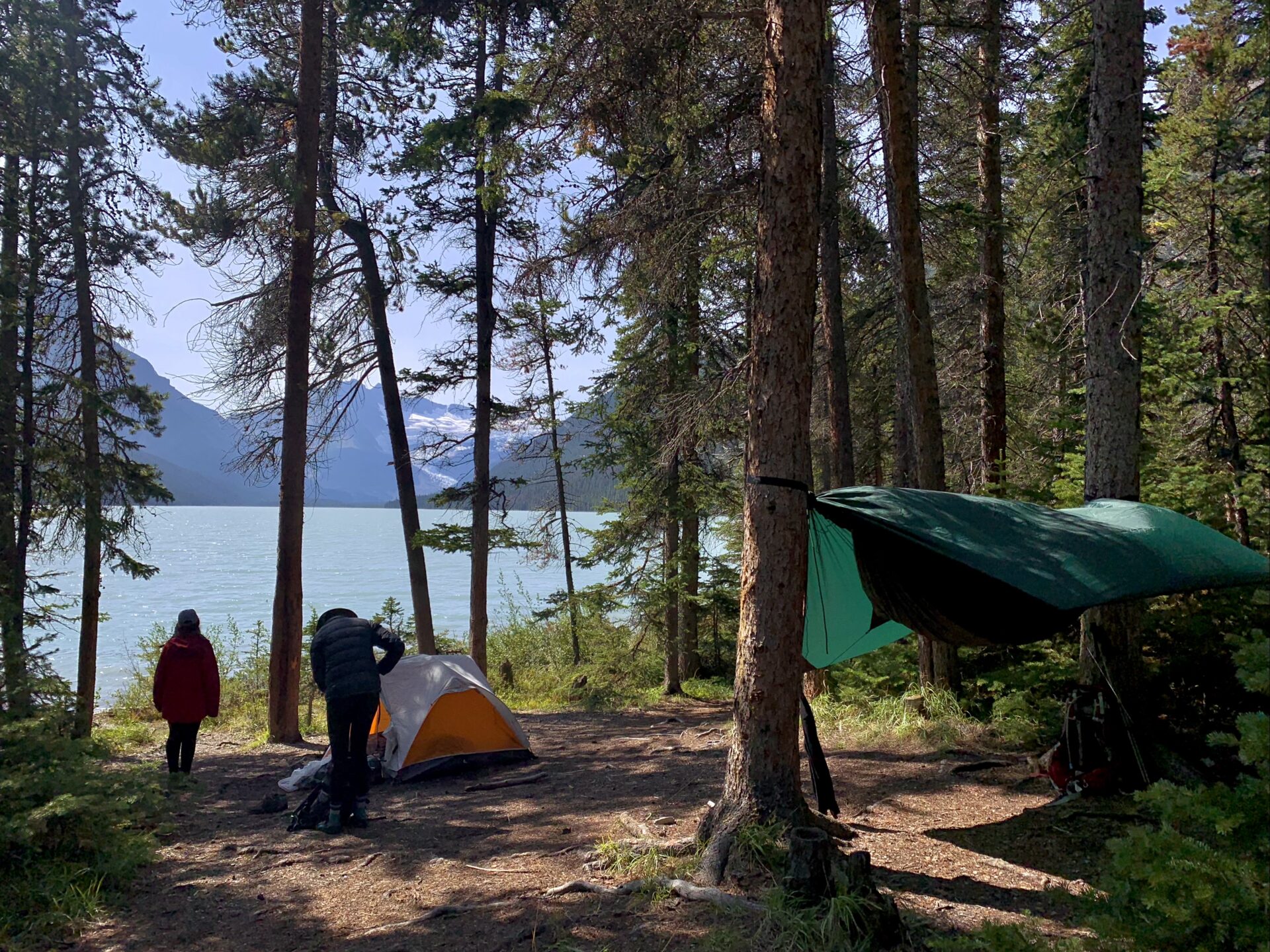
The GL 9 campsite features open tent pads, a communal fire pit, picnic tables with an excellent view of the lake, an outhouse (bring TP), and bear poles. The tent pads themselves aren’t really tent pads and you can pretty much camp wherever you can find flat, open space on the ground. There is a shoreline trail that wraps around the lake, you can follow this which will lead to more flat areas. These spots aren’t technically tent pads, but they are a little more secluded than the main campsite.
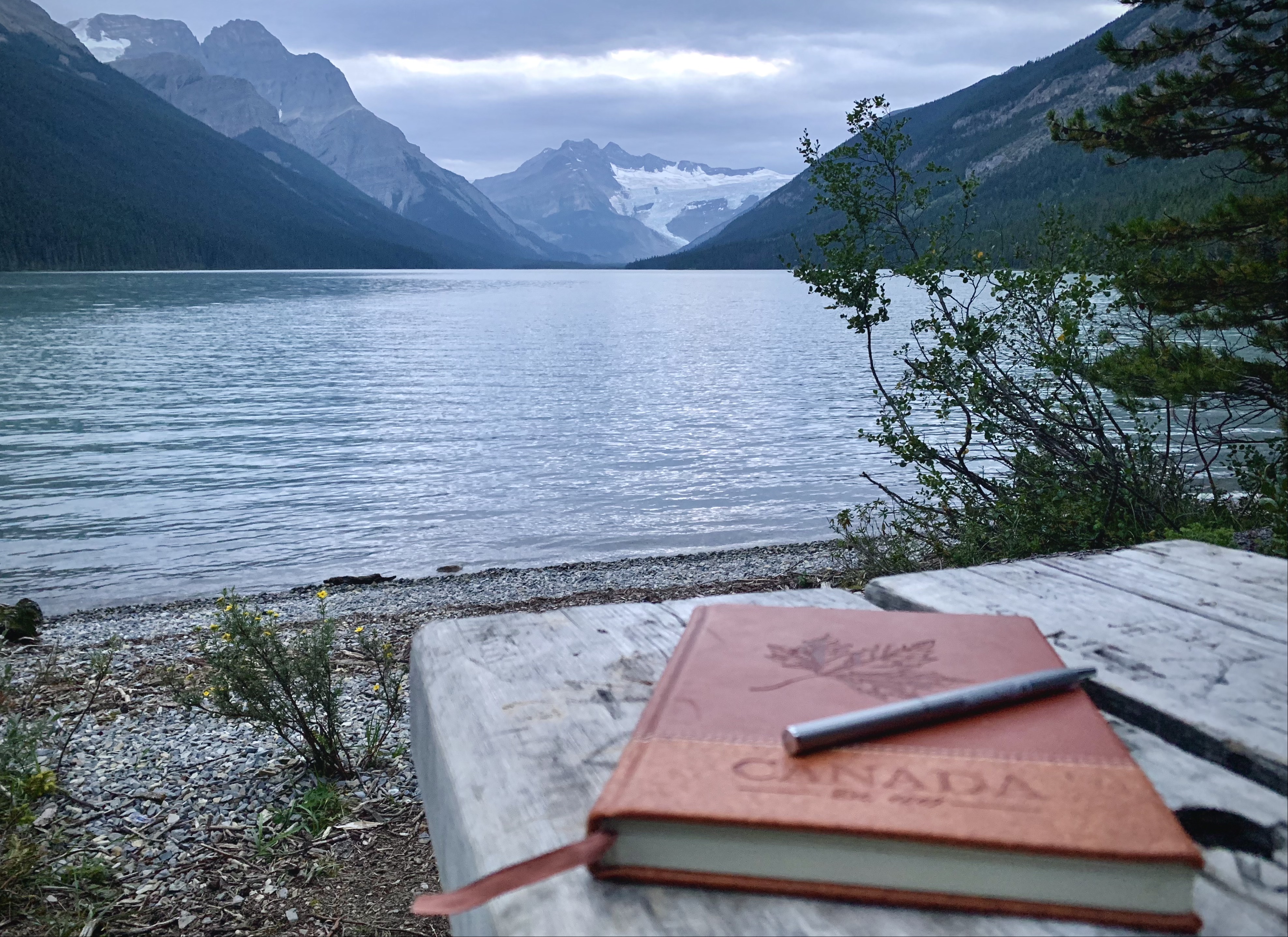

Things To Do At The Campsite
If you’re camping more than one night at the lake, consider doing additional hikes. There are a few trails surrounding the campsite, however I was only there for a night and did not have time to explore them. Upon doing some research I’ve come across Glacier River which is located about 1.4km South-East of the campsite, Survey Peak Trail, and the Howse River Valley Viewpoint trail. To find routes for these trails you’ll need to zoom into the Alltrails map for Glacier Lake (see previous map ^) and seek out the dotted lines that lead you to where you want to go. I’d definitely recommend exploring these trails and wish I had the chance to check them out myself. However since I have not hiked these trails, I cannot comment on their quality or ease of use.
The trail I did use while camping here is one that hugs the shoreline (North side) of the lake. I didn’t walk the entire thing, but according to Alltrails it stretches for 9.2km. The section I walked was nice, flat, and is well marked/easy to navigate. We did it just before bed to warm up for the night.
Connect via socials:
Sign up for emails to receive a 25% discount on my travel maps + occasional updates on new hiking guides & travel resources.
Taylor ♡
Looking for More Banff Adventures?
Banff is an adventurer’s & view seeker’s paradise. If you’re planning a trip to this gorgeous Canadian Park, you can start with this step-by-step guide designed to help you plan the perfect Banff itinerary.
Alternatively, check out this page with all my Banff resources.
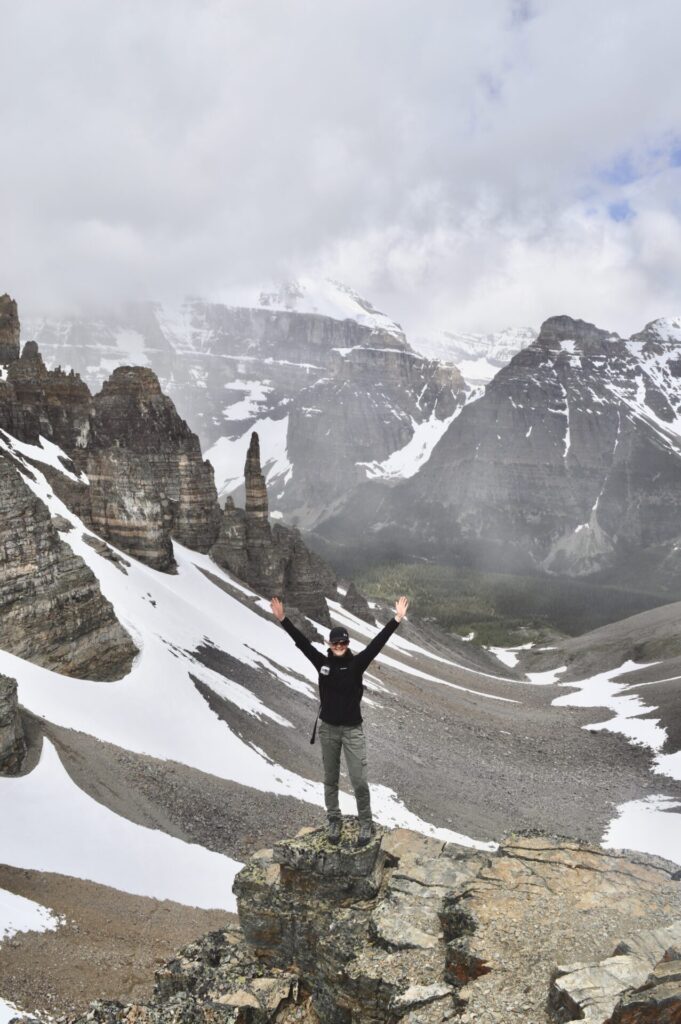
Banff Hiking Resources
On this page you can find all my Banff trail guides. A few signature hikes in Banff are these easy trails, Tunnel Mountain, Sulphur Mountain, Lake Louise, and Johnston Canyon. If you’re only in Banff for a few days, start with those!
A few of my personal favourite hikes in Banff are Mount Bourgeau, Sentinel Pass, Tower of Babel, the Banff Skoki Loop, and the Sulphur Mountain Traverse Route.
More Banff Resources you Might Find Interesting:
Want to continue your Canadian Rockies expedition outside of Banff? Check out my trail guides & travel resources for British Columbia and Kananaskis Country as well as Jasper, Waterton, Yoho, and Kootenay National Parks 🙂
Personal Backpacking Gear Recommendations
Here are my favourite backpacking essentials and items I can’t live without in the backcountry.
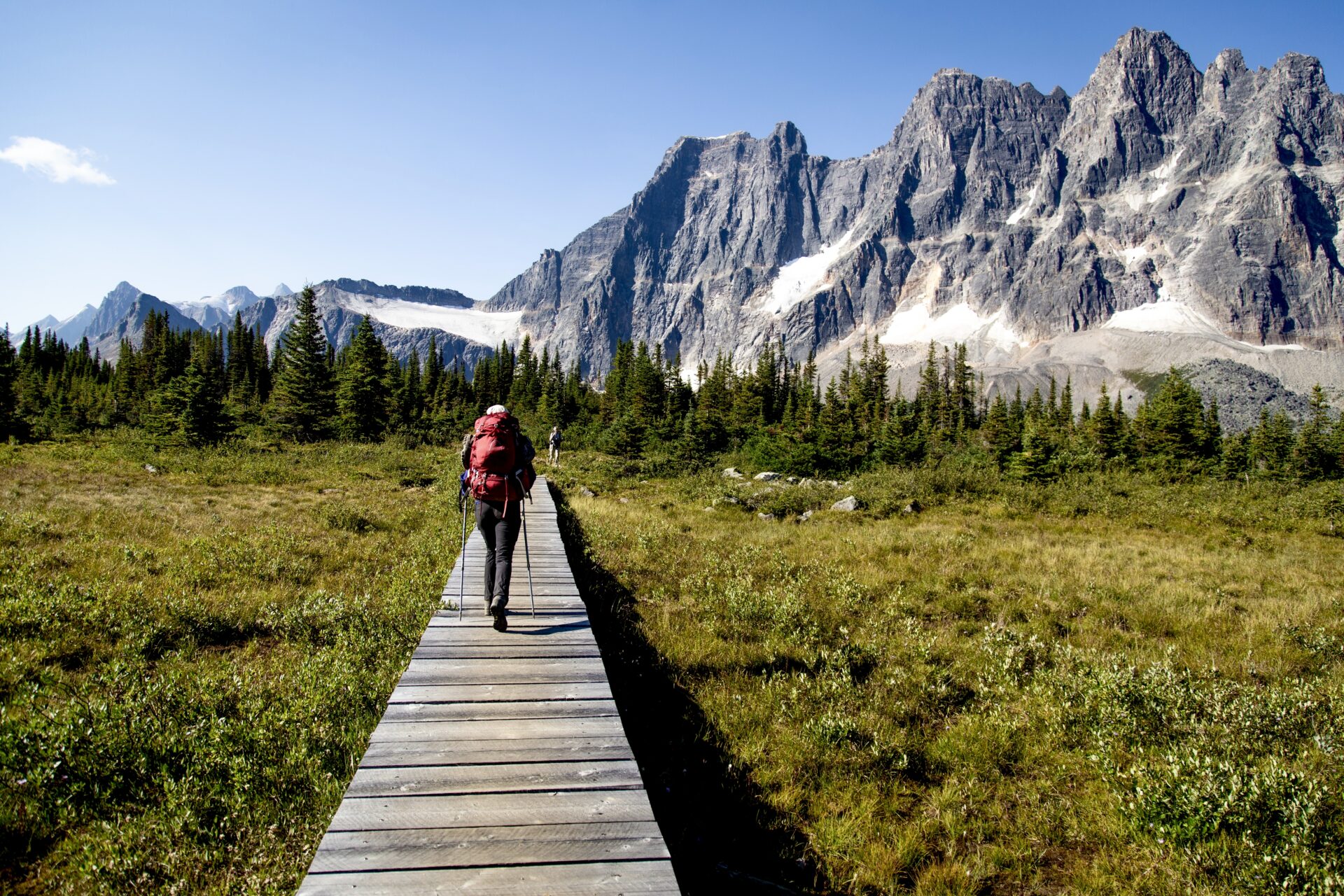
My backcountry gear guide goes into further detail about the below + additional things I bring into the backcountry.
Warmth: as someone with Raynaud’s Disease, one of the trickiest things about backcountry travel is staying warm at night. I wear thick fleece socks and clothes when I sleep in addition to popping Aurora Heat’s reusable fur foot warmers into my socks. For additional warmth you can also fill a Nalgene bottle with boiling water and place it in your sleeping bag overnight. PS – the wide opening Nalgene bottle doubles as an easy way to collect drinking water.
Sleeping: I use the Hotcore winter sleeping bag which has a -20 rating (useful in the Rockies during summer). I also use Hotcore’s fleece sleeping bag liner and the Thermarest NeoAir XLite for my sleeping pad. The MSR Hubba Hubba 2P is my go-to tent.
Cooking: I use the MSR Pocket Rocket Deluxe stove and the RioRand mess kit. I also love Stasher Bags for carrying, rehydrating, and cooking food plus the euroSCRUBBY and slice of this soap for cleanup.
Extras: 3L Hydrapak for water carry and both the Hydrapak attachable filter and aquatabs to clean water. Dry bags for food storage and to keep clothes/electronics dry. I use the women’s Osprey Aura 65L backpack (Osprey Atoms 65L for men). A lightweight camping pillow for comfort and a bug suit if you enjoy keeping your sanity. I also always bring these thin gloves and a toque.
And finally, rain gear. Bring both a rain coat and rain pants as they’re lightweight and make a world of difference if you need an extra layer of warmth or to protect yourself from the elements.
Tips for a Successful Trip
- The Saskatchewan River Crossing (located right by the trailhead) has food, clothes, (expensive) gas, and other amenities
- There are no toilets at the trailhead
- Don’t expect any cell service – this applies for the majority of the drive to the trailhead as well
- Insect repellent is a must if you hike this during bug season (alternatively, bring a bug suit)
- Bring extra layers – the campsite faces the Lyell Glacier which means if it’s windy you’re getting katabatic winds coming directly at your tent
- Wake up early to catch the incredible glass reflection on the lake – make sure to check sunrise & sunset times before leaving for your hike. If you’re lucky you’ll get some alpenglow too!
- Know what to pack
Happy adventuring!
Taylor ♡
Like This Post?
Share with friends or save it for later!
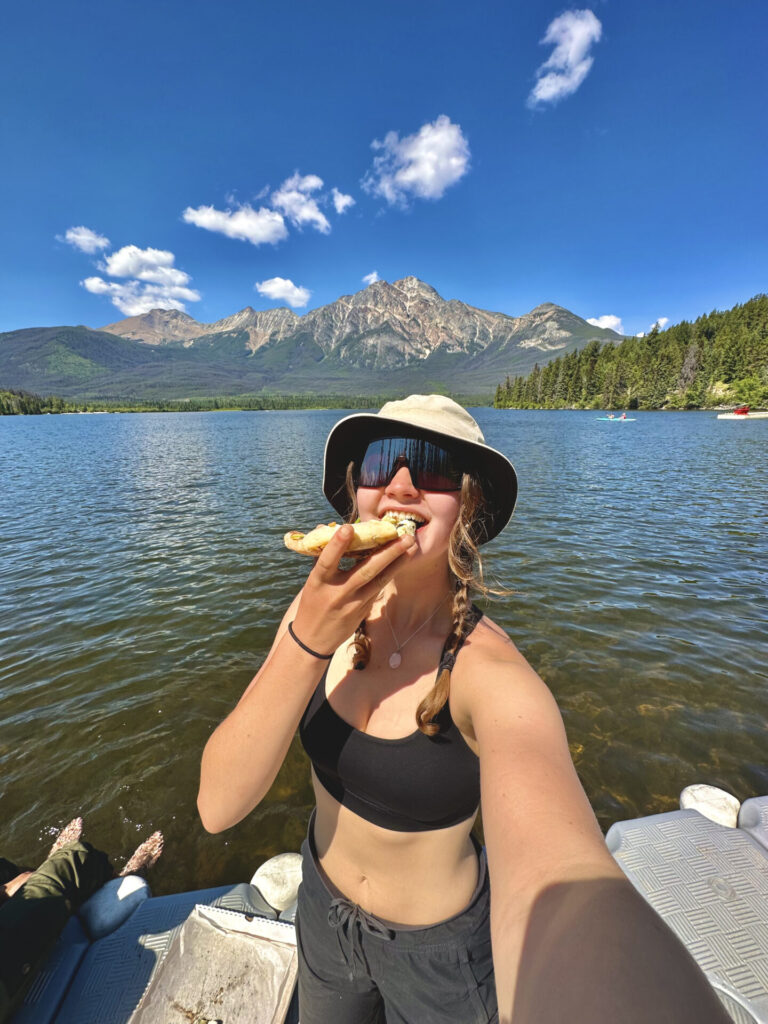
About The Author
HI, I’m Taylor – the voice behind The Holistic Backpacker.
After moving to Banff National Park in 2020 I became an outdoor adventure enthusiast and vowed to never stop exploring.
I now spend my days travelling the world, climbing mountains, and spending nights under the stars in the Canadian Rockies backcountry.
I created The Holistic Backpacker so I could share my adventures and help connect people like you with the same amazing experiences.
